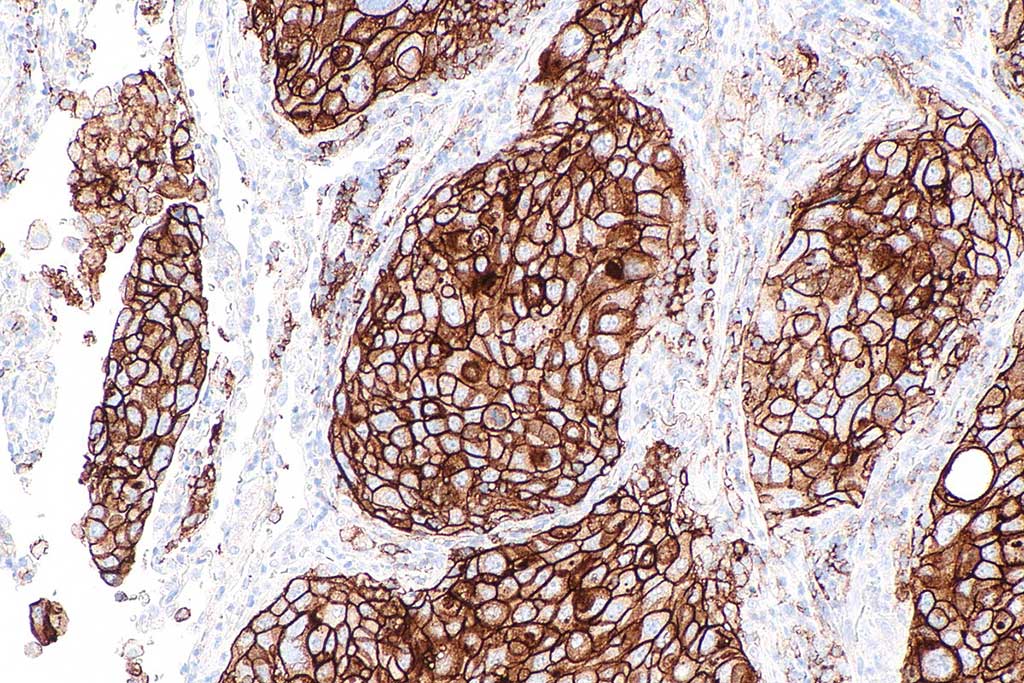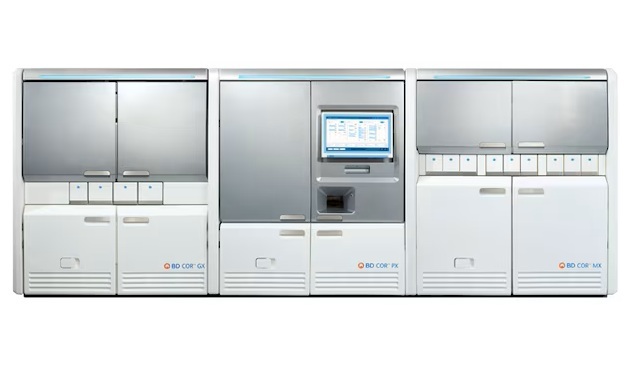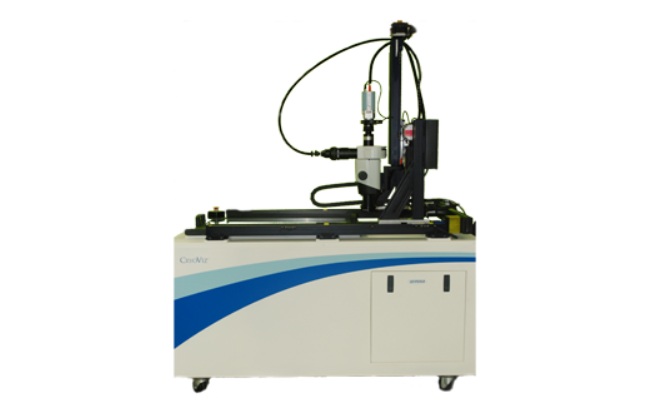Increased Membrane Glycoprotein Level Predicts Lung Cancer Metastasis
|
By LabMedica International staff writers Posted on 25 Mar 2020 |

Image: Micrograph showing a PD-L1 positive non-small cell lung carcinoma (Photo courtesy of Wikimedia Commons)
A protein found in extracellular vesicles (Evs) shed by lung cancer cells was found to be an effective, relatively noninvasive biomarker for the early detection of lung cancer metastasis and could shape the direction of therapeutic decisions.
EVs, which include exosomes, microvesicles, and apoptotic bodies, are cell-derived lipid-bilayer-enclosed structures, with sizes ranging from 30 to 5,000 nanometers. The vesicles, which contain RNA, proteins, lipids, and metabolites that are reflective of the cell type of origin, are either released from the cell when multivesicular bodies (MVBs) fuse with the plasma membrane, or they are released directly from the plasma membrane. In the past decade, EVs have emerged as important mediators of cell communication because they serve as vehicles for the intercellular transmission of biological signals (proteins or nucleic acids) capable of altering cell function and physiology.
Non–small cell lung cancer (NSCLC) is the most commonly diagnosed cancer and the leading cause of cancer death worldwide. More than half of patients with NSCLC die after developing distant metastases, so rapid, minimally invasive prognostic biomarkers are needed to reduce mortality.
To search for such biomarkers, investigators at Tulane University (New Orleans, LA, USA) used mass spectrometry in a proteomics approach to identify proteins differentially expressed on extracellular vesicles of nonmetastatic 393P and metastatic 344SQ NSCLC cell lines.
The investigators reported that they had found that the tetraspanin-8 (Tspan8) protein was selectively enriched on 344SQ Evs. Tspan8 is a member of the transmembrane 4 superfamily, also known as the tetraspanin family. Most of these members are cell-surface glycoproteins that are characterized by the presence of four hydrophobic domains. These proteins, which are expressed in many different carcinomas, mediate signal transduction events that play a role in the regulation of cell development, activation, growth, and motility.
In addition to finding increased Tspan8 on the metastatic cell line, analysis of Tspan8 expression in archived serum samples obtained from patients with NSCLC participating in a clinical trial indicated that serum EV-Tspan8 concentration predicted future metastasis.
"The protein could be used as a biomarker to develop a rapid, minimally invasive test to catch these cancers early when they are more treatable," said senior author Dr. Tony Hu, professor of cellular and molecular diagnosis at Tulane University. "The goal of any cancer diagnosis and treatment is to catch it early. This information could help diagnose patients who are at high risk for having their cancer metastasize, and treatment could be tailored to account for that. Not all patients have the same type of tumor, and if you can target therapy to address a particular tumor, you can improve outcomes."
The lung cancer study was published in the March 11, 2020, online edition of the journal Science Advances.
Related Links:
Tulane University
EVs, which include exosomes, microvesicles, and apoptotic bodies, are cell-derived lipid-bilayer-enclosed structures, with sizes ranging from 30 to 5,000 nanometers. The vesicles, which contain RNA, proteins, lipids, and metabolites that are reflective of the cell type of origin, are either released from the cell when multivesicular bodies (MVBs) fuse with the plasma membrane, or they are released directly from the plasma membrane. In the past decade, EVs have emerged as important mediators of cell communication because they serve as vehicles for the intercellular transmission of biological signals (proteins or nucleic acids) capable of altering cell function and physiology.
Non–small cell lung cancer (NSCLC) is the most commonly diagnosed cancer and the leading cause of cancer death worldwide. More than half of patients with NSCLC die after developing distant metastases, so rapid, minimally invasive prognostic biomarkers are needed to reduce mortality.
To search for such biomarkers, investigators at Tulane University (New Orleans, LA, USA) used mass spectrometry in a proteomics approach to identify proteins differentially expressed on extracellular vesicles of nonmetastatic 393P and metastatic 344SQ NSCLC cell lines.
The investigators reported that they had found that the tetraspanin-8 (Tspan8) protein was selectively enriched on 344SQ Evs. Tspan8 is a member of the transmembrane 4 superfamily, also known as the tetraspanin family. Most of these members are cell-surface glycoproteins that are characterized by the presence of four hydrophobic domains. These proteins, which are expressed in many different carcinomas, mediate signal transduction events that play a role in the regulation of cell development, activation, growth, and motility.
In addition to finding increased Tspan8 on the metastatic cell line, analysis of Tspan8 expression in archived serum samples obtained from patients with NSCLC participating in a clinical trial indicated that serum EV-Tspan8 concentration predicted future metastasis.
"The protein could be used as a biomarker to develop a rapid, minimally invasive test to catch these cancers early when they are more treatable," said senior author Dr. Tony Hu, professor of cellular and molecular diagnosis at Tulane University. "The goal of any cancer diagnosis and treatment is to catch it early. This information could help diagnose patients who are at high risk for having their cancer metastasize, and treatment could be tailored to account for that. Not all patients have the same type of tumor, and if you can target therapy to address a particular tumor, you can improve outcomes."
The lung cancer study was published in the March 11, 2020, online edition of the journal Science Advances.
Related Links:
Tulane University
Latest Molecular Diagnostics News
- Blood Test to Help Low-Risk Gastric Cancer Patients Avoid Unnecessary Surgery
- First-Of-Its-Kind Automated System Speeds Myeloma Diagnosis
- Blood Protein Profiles Predict Mortality Risk for Earlier Medical Intervention
- First Of Its Kind Blood Test Detects Gastric Cancer in Asymptomatic Patients
- Portable Molecular Test Detects STIs at POC in 15 Minutes
- Benchtop Analyzer Runs Chemistries, Immunoassays and Hematology in Single Device
- POC Bordetella Test Delivers PCR-Accurate Results in 15 Minutes
- Pinprick Blood Test Could Detect Disease 10 Years Before Symptoms Appear
- Refined C-Reactive Protein Cutoffs Help Assess Sepsis Risk in Preterm Babies
- Blood Test Accurately Detects Brain Amyloid Pathology in Symptomatic Patients
- New Molecular Test Improves Diagnostic Accuracy of Lyme Disease
- New Genetic Test Enables Faster Diagnosis of Rare Diseases
- Urine Test Detects Inherited Neuropathy Missed by Genetic Screening
- Genomic Test Predicts Risk of SCC Metastasis
- Microfluidic Device Predicts Pancreatic Cancer Recurrence After Surgery
- New Molecular Test Simultaneously Detects Three Major Fungal Infections
Channels
Clinical Chemistry
view channel
Chemical Imaging Probe Could Track and Treat Prostate Cancer
Prostate cancer remains a leading cause of illness and death among men, with many patients eventually developing resistance to standard hormone-blocking therapies. These drugs often lose effectiveness... Read more
Mismatch Between Two Common Kidney Function Tests Indicates Serious Health Problems
Creatinine has long been the standard for measuring kidney filtration, while cystatin C — a protein produced by all human cells — has been recommended as a complementary marker because it is influenced... Read moreHematology
view channel
Platelet Activity Blood Test in Middle Age Could Identify Early Alzheimer’s Risk
Early detection of Alzheimer’s disease remains one of the biggest unmet needs in neurology, particularly because the biological changes underlying the disorder begin decades before memory symptoms appear.... Read more
Microvesicles Measurement Could Detect Vascular Injury in Sickle Cell Disease Patients
Assessing disease severity in sickle cell disease (SCD) remains challenging, especially when trying to predict hemolysis, vascular injury, and risk of complications such as vaso-occlusive crises.... Read more
ADLM’s New Coagulation Testing Guidance to Improve Care for Patients on Blood Thinners
Direct oral anticoagulants (DOACs) are one of the most common types of blood thinners. Patients take them to prevent a host of complications that could arise from blood clotting, including stroke, deep... Read moreImmunology
view channel
Gene Signature Test Predicts Response to Key Breast Cancer Treatment
DK4/6 inhibitors paired with hormone therapy have become a cornerstone treatment for advanced HR+/HER2– breast cancer, slowing tumor growth by blocking key proteins that drive cell division.... Read more
Chip Captures Cancer Cells from Blood to Help Select Right Breast Cancer Treatment
Ductal carcinoma in situ (DCIS) accounts for about a quarter of all breast cancer cases and generally carries a good prognosis. This non-invasive form of the disease may or may not become life-threatening.... Read moreMicrobiology
view channel
Rapid Assay Identifies Bloodstream Infection Pathogens Directly from Patient Samples
Bloodstream infections in sepsis progress quickly and demand rapid, precise diagnosis. Current blood-culture methods often take one to five days to identify the pathogen, leaving clinicians to treat blindly... Read more
Blood-Based Molecular Signatures to Enable Rapid EPTB Diagnosis
Extrapulmonary tuberculosis (EPTB) remains difficult to diagnose and treat because it spreads beyond the lungs and lacks easily accessible biomarkers. Despite TB infecting 10 million people yearly, the... Read more
15-Minute Blood Test Diagnoses Life-Threatening Infections in Children
Distinguishing minor childhood illnesses from potentially life-threatening infections such as sepsis or meningitis remains a major challenge in emergency care. Traditional tests can take hours, leaving... Read more
High-Throughput Enteric Panels Detect Multiple GI Bacterial Infections from Single Stool Swab Sample
Gastrointestinal (GI) infections are among the most common causes of illness worldwide, leading to over 1.7 million deaths annually and placing a heavy burden on healthcare systems. Conventional diagnostic... Read morePathology
view channelAI Tool Outperforms Doctors in Spotting Blood Cell Abnormalities
Diagnosing blood disorders depends on recognizing subtle abnormalities in cell size, shape, and structure, yet this process is slow, subjective, and requires years of expert training. Even specialists... Read more
AI Tool Rapidly Analyzes Complex Cancer Images for Personalized Treatment
Complex digital biopsy images that typically take an expert pathologist up to 20 minutes to assess can now be analyzed in about one minute using a new artificial intelligence (AI) tool. The technology... Read moreTechnology
view channel
AI Saliva Sensor Enables Early Detection of Head and Neck Cancer
Early detection of head and neck cancer remains difficult because the disease produces few or no symptoms in its earliest stages, and lesions often lie deep within the head or neck, where biopsy or endoscopy... Read more
AI-Powered Biosensor Technology to Enable Breath Test for Lung Cancer Detection
Detecting lung cancer early remains one of the biggest challenges in oncology, largely because current tools are invasive, expensive, or unable to identify the disease in its earliest phases.... Read moreIndustry
view channel
Abbott Acquires Cancer-Screening Company Exact Sciences
Abbott (Abbott Park, IL, USA) has entered into a definitive agreement to acquire Exact Sciences (Madison, WI, USA), enabling it to enter and lead in fast-growing cancer diagnostics segments.... Read more






















